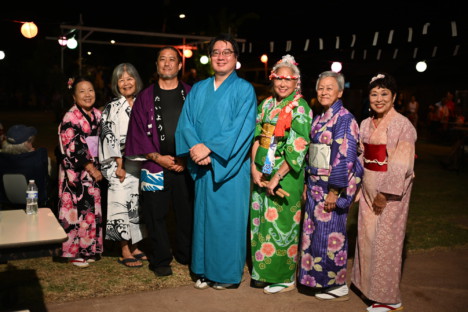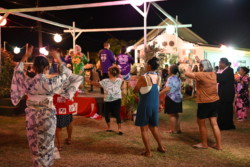The Spirit of Obon
By Léo Azambuja
When the first Japanese immigrants arrived in Hawai‘i in the 19th century to work on sugar plantations, they brought the bon dance with them, which would become an integral, colorful part of Hawaiʻi’s folk and religious tradition.
“It’s a symbolic dance, where we dance with our departed loved ones who have passed on. And this is a very traditional Japanese and Buddhist practice,” Buddhist Bishop Shuji Komagata said at the Guzeiji Soto Mission’s Bon Dance in Kaunakakai Saturday evening.
During the Obon season, the spirits of the deceased return home to visit their families. Chochins, or paper lanterns, help the spirits find their way home and join their families in the bon dances. Usually, a bonfire sends off the spirits at the end of the celebration.
Despite Guzeiji Soto Mission being a small congregation — they have 18 members — their bon dance was attended by a couple hundred people, with 30 or 40 taking active participation in the traditional dances around the yagura, or stage, at any given time.
The lawn fronting the Buddhist temple was decorated with several chochins. The yagura was placed in the center of the lawn, with several picnic tables accommodating the public.
As in most festivals in Hawaii, food is an important part. There were chicken hekka plates for sale, as well as musubi, saimin, tarts, sushi, manju and drinks. A two-dollar raffle ticket placed in a large bin put you in a drawing for several prizes, including gift bags, two-night stays in a beach-front condo, gift certificates and $1,000 in cash.
The chief priest of the Soto Mission of Hawaii and director of the Soto Zen Buddhism Hawaii Office, Komagata came from Oahu for the annual festival, which he called “an annual reunion with our departed loved ones.”
Prior to the bon dance, Komagata led the temple’s members during a service at Kapa‘akea Cemetery at 4 p.m., when they offered prayers to those who have passed away.
Guzeiji Soto Mission member Marge Yokomizo-Bento — who frequented the temple since she was a young child — said that during the services, they invited their loved ones who have passed on to celebrate at night.
“We write their names on a paper called ofuda, and then at the end of the night we burn it,” Yokomizo-Bento said. “We send them off.”
Komagata took the center stage alongside the taiko drummers, who also came from Oahu. The evening’s most popular song, Fukushima Ondo, was performed at least three times.
“My favorite song is Fukushima,” Yokomizo-Bento said.
Fukushima Ondo is a folk song popular in bon dances, originated in Japan’s Fukushima region. The dance for the song is performed in a clockwise manner, with distinct left-and-right steps, throwing the arms over the shoulder and clapping to the rhythm.
A group of dancers from Oahu also came to Molokai specifically for the occasion. The Waipahu Taiyoji Soto Mission Bon Dance Class, led by sensei Derrick Iwata, wore colorful traditional kimonos, mixing with Molokai residents during the dances.
Guzeiji Soto Mission President Lisa Takata said the congregation hasn’t had a resident minister for many years. Komagata comes from Oahu usually every quarter for special occasions. The bon dance is celebrated on Molokai for several decades, and 2028 will mark the temple’s 100th anniversary.
“We are planning a large celebration,” said Takata, who helped to organized the bon dance along with Yokomizo-Bento.
“There’s a saying, ‘I am what I am because of you,’” Takata said. “So, ‘I am what I am because of the people in the past.’”
The story of Obon goes back to India more than 2,500 years ago. Mokuren, a disciple of Buddha, used his supernatural powers to discover his deceased mother suffering; she had fallen in the realm of hungry ghosts, and was always hungry and thirsty.
Buddha gave Mokuren a series of tasks, eventually leading to his mother’s release. Doing so, Mokuren understood the nature of the unselfish sacrifices his mother had made for him. Happy with the outcome, he danced with joy.
From this joyful dance comes the bon odori, or bon dance, a time when ancestors and their sacrifices are remembered and celebrated.
As buddhism spread throughout Asia, it eventually reached Japan. In the Heian period (794-1185 AD), the bon odori evolved from the popular Odori Nembutsu Buddhist chant. By the 1600s, the Obon was widespread throughout Japan, especially in rural communities, where it meant a break from the monotony of farm life.
Komagata said it was very special for him, the taiko drummers and the dancers to come to Molokai.
“Molokai is a very warm community, and just we feel very welcome when we come here,” he said.
Yokomizo-Bento invited everyone in the community to join them for the zazen meditation at the Guzeiji Soto Mission temple in Kaunakakai every Sunday at 8:30 a.m.













Don't have a Molokai Dispatch ID?
Sign up is easy. Sign up now
You must login to post a comment.
Lost Password